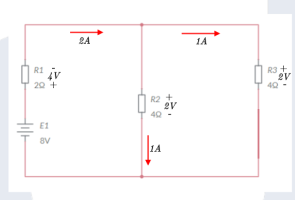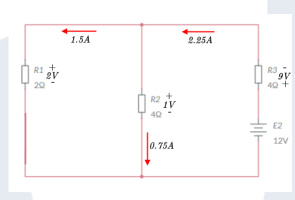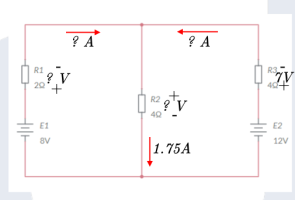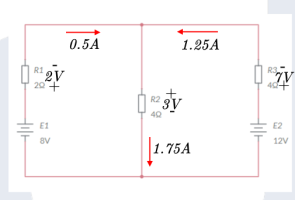Scott92
New member
- Joined
- Jun 11, 2022
- Messages
- 41
Hi is anyone any good with superposition as im not, i've done what i believe is correct to work out current at each resistors but im not sure its correct,
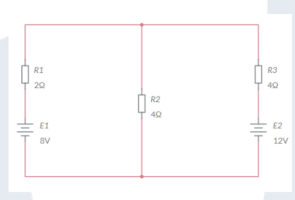 Thats my circuit ive got R1 at 0.9 R2 at 1.95 and R3at -1.05 Ive got to these numbers by doing E2 to short
Thats my circuit ive got R1 at 0.9 R2 at 1.95 and R3at -1.05 Ive got to these numbers by doing E2 to short
4x2/4+2=1.33 I1=8/2+1.33=2.40 I2=2.40x4/(4+4)=1.2 I3=2.40x4/(4+4)=1.2
E1 to short I4=12/4+1.33=2.25 I5=2.25x2/(2+4)=0.75 I6=2.25x4/(2+4)=1.50
R1= I1-I6 R2=I3+I5 R3=I2-I4 Is this correct or am i miles away tried youtube videos but struggle find simple circuits on there.
 Thats my circuit ive got R1 at 0.9 R2 at 1.95 and R3at -1.05 Ive got to these numbers by doing E2 to short
Thats my circuit ive got R1 at 0.9 R2 at 1.95 and R3at -1.05 Ive got to these numbers by doing E2 to short4x2/4+2=1.33 I1=8/2+1.33=2.40 I2=2.40x4/(4+4)=1.2 I3=2.40x4/(4+4)=1.2
E1 to short I4=12/4+1.33=2.25 I5=2.25x2/(2+4)=0.75 I6=2.25x4/(2+4)=1.50
R1= I1-I6 R2=I3+I5 R3=I2-I4 Is this correct or am i miles away tried youtube videos but struggle find simple circuits on there.

